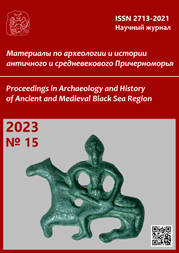Нумизматические находки из средневекового ритуально-культового комплекса в Дербенте
Numismatic finds from the medieval religious and ritual complex in Derbent
Author(s): Murtazali Gadjiev, G.V. ZlobinSubject(s): History, Archaeology, Cultural history, Middle Ages
Published by: Нижневартовский государственный университет
Keywords: Caucasus; Derbent; religious site; Islamic numismatics; fals; dirham; Umayyads; Abbassids; Sulamids; Ildegizids; Pishkinids; Aq Sunqurids;
Summary/Abstract: During rescue excavations in Derbent in 2014, a Muslim ritual complex connected with a water supply system and apparently serving for ritual washing and cleansing was revealed outside the medieval shahristan and near the north defensive wall of the city. In addition to numerous and diverse finds, 57 coins were found, which is obviously due to the nature of the place where coins were left as ‘offerings’ in fulfillment of the vow. The absolute majority of identified coins (48 items) represent two chronological groups. The early chronological group (12 items) consists of Umayyad and Abbasid fulus of the 8th century, including the mint of Bab al-abwab (Derbent) and the fulus of the type of the Arran governor Hassan b. Kakhtaba (770—775). Most coins of this group (10 items) were found in a small area (ca. 2 sq. m) in the same stratigraphic position fixing the level of the ancient day surface.The late chronological group (36 items) includes copper dirhams of Bab al-abwab Sulamids mainly of the mid-12th c. — late 12th c. (13 items), Akhar malik Mahmud b. Pishkin (1211—1226) (7 items), Ildegizids during the reign of Caliph al-Nasir (1180—1225) (8 coins), and Aq Sunqurids (1189—1207) (8 items), including a coin with the name of Ildegizid atabek Kizil Arslan (1186—1191). Eighteen coins of this group were also found in a small area (ca. 4 sq. m) in the same stratigraphic position as those 10 coins of the early group mentioned above.The whole archaeological assemblage, including coins, indicate that the religious object ceased its functioning in direct association with the invasion of the Mongols led by Jebe and Subutai, the subsequent invasion of Khwarazmshah Jalal ad-Din in the Caucasus, and the conquest of Derbent by Bukdai, a commander of Möngke Khan, in 1239.
Journal: Материалы по археологии и истории античного и средневекового Причерноморья
- Issue Year: 2023
- Issue No: 15
- Page Range: 806-833
- Page Count: 28
- Language: Russian

